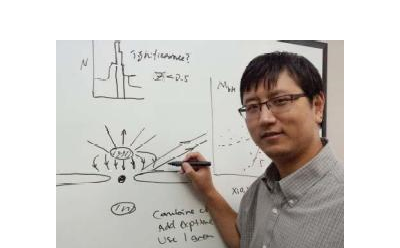
B.S. Beijing University (1998)
Ph.D. Pennsylvania State University (2004)
My research interests lie in understanding astronomical objects such as gravitational lenses, galaxy clusters, active galactic nuclei, and gamma-ray bursts.
Since the discovery of the first cosmological gravitational lens in 1979, gravitational lensing has become an important tool in many astrophysical applications. In particular, quasar microlensing provides a novel method to map the quasar accretion disk structure. Utilizing the dependence of microlensing variability on the source size, we are able to resolve the disk structure that is several orders of magnitude smaller than the angular resolution of our current telescopes. Beside quasar microlensing, I am also interested in probing the interstellar medium of lens galaxies, and exploring the embedded lensing model.
Galaxy clusters are the largest gravitationally bound objects in the universe. They are ideal sites to constrain cosmological parameters and study structure formation. I am currently working on the Swift soft X-ray serendipitous cluster survey. The survey has the potential to find one of the largest X-ray selected cluster catalog to date. I also study the missing Baryon problem in the universe.
Active galactic nuclei (AGNs) are very energetic sources in the universe powered by supermassive black holes. I am interested in the feedback process of AGNs to their host galaxies, in particular, the kinetic feedback carried out by winds. I am working on measuring the intrinsic fractions of broad absorption line quasars of various species and the average absorption column densities of these objects. In addition, I also study the relationships between various AGN parameters such as the broadband spectral index, X-ray spectral index, luminosity, Eddington ratio, and variability with the aim to constrain AGN physics.
Gamma-ray bursts (GRBs) are the biggest explosions in the universe after the Big Bang. I am working on the population studies of GRBs, which include constraining the GRB jet structure from both observational and theoretical approaches.